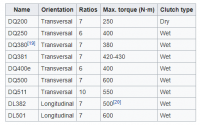So I'm back from my test drive(s) We still also have our T5 so I took that out too as a back-to-back comparison. I apologize in advance for the essay which follows....
The issue seems to be throttle / clutch / gearbox related (which I assume are all aspects of the DSG box).
Creeping when maneuvering
At low revs the engine in the T5 gives the impression of being far more powerful than the T6. Taking your foot off the brake in the T5 will move you forwards (or backwards when in R) at a reasonable pace, enough for slow speed maneuvering to park without having to touch the throttle. While the T6 moves at a snails pace when the brake is released which forces you to press the throttle most of the time. In the T5 a small press on the pedal has a marked effect while in the T6 you need to move it quite a long way to achieve any results.
I tried reversing up a slight hill in the T6. Initially the hill-hold feature held it after I released the brake. Tapping the throttle released the hill-hold but at idle (800 rpm) the gearbox wasn't delivering enough power to hold the vehicle so it started to roll forwards again. I quickly had to press the throttle to stop me rolling into a post in front of me and eventually got me moving up the hill. It felt less than satisfactory! On the same hill in the T5 as soon as I tapped the throttle to release the hill-hold the van started moving up the hill. No need to depress the throttle at all.
Now for accelerating from a standstill
In the T6 I released the brake and the van started to creep forwards at 800 rpm. I pressed the throttle and the revs rose to just over 2K rpm but with no corresponding change to the speed of the van. After a second or so the van suddenly accelerated and the revs rose to nearly 3K rpm. Then second gear engaged and we were off. It didn't seem to matter how hard I pressed the pedal - the first bit was always exactly the same. It was only after the second delay, when the power kicked in, that it became apparent how hard the pedal had been pressed as we would either move off smoothly or like a rocket. There is no feedback to let the driver know how much gas has been applied until it's too late.
In the T5 I released the brake and the van started to move forwards purposefully at 800 rpm. Pressing the throttle caused the van to accelerate slowly but the revs rose much more quickly than the speed. After half a second or so the van suddenly accelerated and the revs rose to nearly 3K rpm. Then second gear engaged and we were off. The difference to the T6 being that, before the clutch engaged, the revs seemed to rise higher depending on how much gas had been applied, giving valuable feedback to gauge how fast we'd launch once the clutch engaged.
To conclude
I suspect that there are 3 differences between our T5 and our T6 which result in an unsatisfying drive in the T6:
1) The clutch biting point. At low speed I suspect that the clutch is slipping in the T6 at idle which would explain why the van can still roll forwards or backwards when supposedly in gear and on a slight slope. The clutch transfers far more power in the T5 when the engine is idling.
2) The throttle response. It's a long way from linear which gives the feel that the engine is feeble when depressed lightly and the point at which it changes to unleash more power is quite sudden and unexpected. The T5 feels more linear.
3) The way in which the revs are restricted when slipping the clutch in 1st gear gives no feedback to the driver to help gauge the throttle position. It seems better in the T5.
@Marty78 does this still sound familiar?
I wonder if any of these things can be fixed or if it's just the way it is and we'll either have to live with it or go back to our T5
















